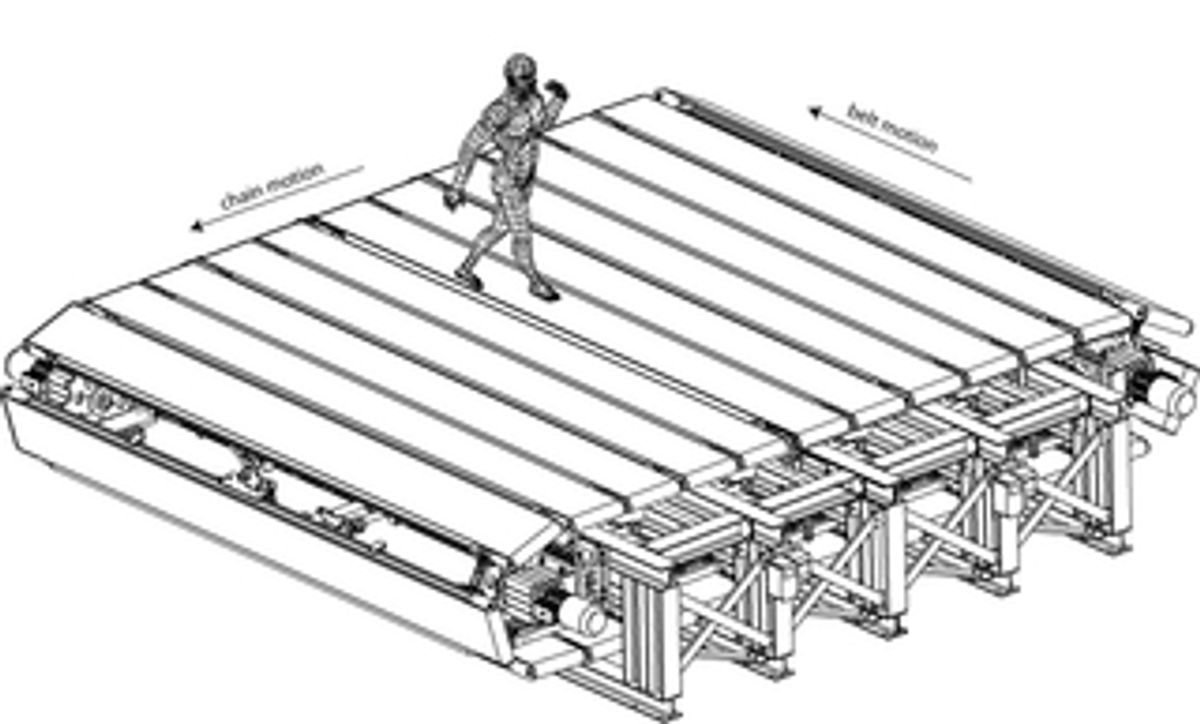It's a problem that has long annoyed virtual reality researchers: VR systems can create a good experience when users are observing or manipulating the virtual world (think Michael Douglas in "Disclosure") but walking is another story. Take a stroll in a virtual space and you might end up with your face against a real-world wall.
The same problem is becoming apparent in teleoperated robots. Imagine you were teleoperating a humanoid robot by wearing a sensor suit that captures all your body movements. You want to make the robot walk across a room at the remote location -- but the room you're in is much smaller. Hmm.
Researches have built a variety of contraptions to deal with the problem. Like a huge hamster ball for people, for example.
Or a giant treadmill. The CyberWalk platform is a large-size 2D omni-directional platform that allows unconstrained locomotion, adjusting its speed and direction to keep the user always close to the center. With a side of 5 meters, it's the largest VR platform in the world.
Built by a consortium of German, Italian, and Swiss labs, the machine currently resides at the Max Planck Institute for Biological Cybernetics, in Tubingen, Germany, where it's been in operation for over two years.
Last year at IROS, Alessandro De Luca and Raffaella Mattone from the Universita di Roma "La Sapienza," in Rome, Italy, and Paolo Robuffo Giordano and Heinrich H. Bulthoff from the Max Planck Institute for Biological Cybernetics presented details of the machine's control system.
According to the researchers, previous work on similar platforms paid little attention to control algorithms, relying on simple PID and heuristic controllers.
The Italian and German researchers came up with a kinematic model for the machine and from there they devised a control strategy. Basically the challenge is that the control system needs to adapt to changes in the user's direction and speed -- variables that it can't measure directly, so it needs to estimate them.
By precisely monitoring the position of the user on the platform using a Vicon motion-capture system, the controller computes estimates for the two variables and tries to adjust the speeds of the linear belts to keep the user close to the center -- all without abrupt accelerations.
The researchers also devised a way of using a frame of reference for the controller that varies with the user's direction. This method allowed the CyberWalk platform to provide a more natural walking experience, without making the user's legs cross when changing direction. The video above shows the results.
The CyberWalk platform is one of two locomotion devices developed as part of the European Union-funded Project CyberWalk. The other is a small-scale ball-array platform dubbed CyberCarpet.
The Technical University of Munich, another partner in the CyberWalker consortium, designed and built both platforms. And ETH Zurich, another partner, was responsible for the VR part -- creating a 3D VR model of ancient Pompeii and implementing the motion synchronization on the head-mounted display of the human walker.
You can read the researcher's paper, "Control Design and Experimental Evaluation of the 2D CyberWalk Platform," here.
Photo: CyberWalk Project
READ ALSO:
Blog Post: It only has one wheel, but Honda's futuristic personal mobility device is no pedal-pusher
Blog Post: Japanese researchers demonstrate a robotic wheelchair operated with Wii game controller
Blog Post: There are 8.6 million robots in the world -- or more than one automaton for every person in Austria
Blog Post: The French robotics company has introduced a robot designed to assist elderly and disabled people in their daily activities
Erico Guizzo is the director of digital innovation at IEEE Spectrum, and cofounder of the IEEE Robots Guide, an award-winning interactive site about robotics. He oversees the operation, integration, and new feature development for all digital properties and platforms, including the Spectrum website, newsletters, CMS, editorial workflow systems, and analytics and AI tools. An IEEE Member, he is an electrical engineer by training and has a master’s degree in science writing from MIT.









